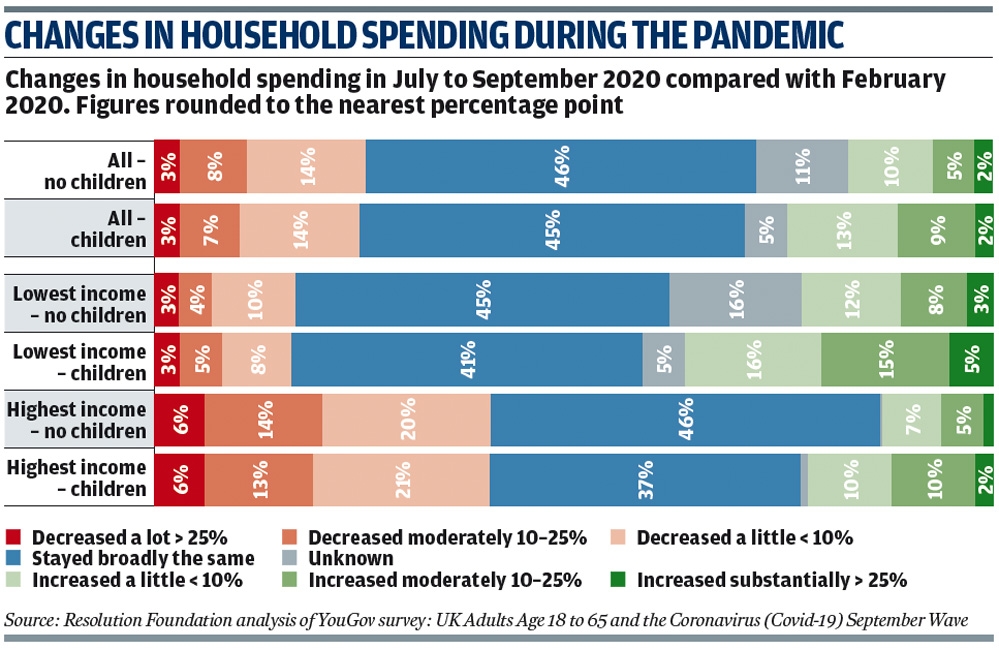- Report PDF: Why Families on a Low Income are Spending More During Covid-19
- Authors: Mike Brewer and Ruth Patrick
- Published by: Resolution Foundation, January 2021
SUMMARY
The Pandemic Pressures study is a collaboration between the Resolution Foundation think-tank and the Nuffield Foundation-funded Covid Realities research project at the University of York. In general, average household spending has fallen by 10 per cent during the pandemic with decreased spend on leisure activities, meals out, holidays and commuting costs.
The researchers wanted to find out whether this overall drop in spending and a rise in saving reflected the experience of all households, looking at income and family type. They analysed data from two online surveys of more than 6,000 adults commissioned by the Resolution Foundation in May and September 2020. They also looked at data from the Covid Realities participatory research programme, which sees parents and carers from across the UK share everyday experiences of the pandemic.
The first survey found that in May 2020, 40 per cent of families were spending less than before the pandemic. However, this was the situation for only 29 per cent of the lowest income families with children. Among those without children in the top income bracket, 58 per cent were spending less.

The second survey found families with children, across all income levels, were more likely to have reported increases in spending in the summer of 2020 compared with families without children. Families on a low income with children were the most likely to report they were spending more during the pandemic. More than a third – 36 per cent – of the lowest income families with children increased their spending during the summer of 2020 with only 18 per cent seeing lower spending than usual between July and September. By contrast, only 13 per cent of high-income families without children had increased their spending compared with 40 per cent who had reduced it.
The qualitative research uncovered three factors underpinning increased spending among parents and carers on a low income. Having children at home more requires higher spending on food, energy bills and ways to entertain or distract them. Meanwhile remote schooling has been very expensive for families that have had to buy a laptop or arrange for broadband access. The additional costs attached to having children at home more of the time were particularly pronounced in spring and summer 2020. But this continued to be an issue through the rest of 2020 as schools asked children or whole year groups to self-isolate after being exposed to a positive case.
The cost of some items, especially food, has risen for many. Promotions have been reduced, cheaper items are harder to obtain and many families have been forced to use closer but more expensive shops. Restrictions on households mixing and non-essential trips have prevented parents from getting help from their wider family and the community while vital free services such as libraries have often been closed.
The survey also found 39 per cent of the lowest income families with children have been “squeezed” as their incomes have fallen by more than their spending. Just under one in three – 29 per cent – of the lowest income families without children were in the same position and this was the case for 31 per cent of the highest income families with children and 22 per cent of the highest income families with no children. Many of the participants in Covid Realities documented how financial insecurity was adversely affecting their mental health and this had in turn led to increased spending in an effort to boost wellbeing.
IMPLICATIONS FOR PRACTICE
When Covid-19 hit, many of the mechanisms for navigating life on a low income became very difficult, if not impossible, to sustain, such as using charity shops or shopping around for a bargain. The authors say the coming months look set to resemble the spring 2020 lockdown with parents facing another difficult period of increased costs. They are calling on the government to confirm the continuation of the £20-a-week uplift to Universal Credit introduced in April 2020. The authors also want the government to consider whether more support for families with children is needed.
FURTHER READING
- Poverty in the Pandemic: The Impact of Coronavirus on Low-Income Families and Children, Sophie Howes and others, Child Poverty Action Group and The Church of England, August 2020
- Generation Covid: Emerging Work and Education Inequalities, Lee Elliot Major, Andrew Eyles and Stephen Machin, Centre for Economic Performance, October 2020
- Destitution in the UK 2020, Suzanne Fitzpatrick and others, Joseph Rowntree Foundation, December 2020

